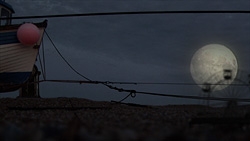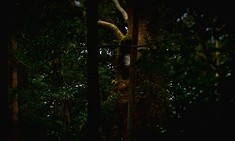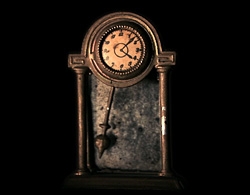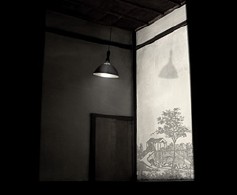I tend to be in limbo to start with, and insert lies in each piece as I go along.

Artist Sawa Hiraki is best known for films suffused with subtle smatterings of lyrical fabrication, commonly set in his own flat. We talked to him about what lies behind the fantastical realm of his works, at first glance extraordinarily personal, but in fact open to interpretation by viewers any way they wish, and his most recent views on video production.
Interview: Ito Toyoko
Portrait: Ronald Dick
– Your debut offering the animated video dwelling memorably featured aeroplanes, a quintessentially boyish motif. What sort of child were you?
A perfectly ordinary one, as far as I can remember. Raised in an ordinary family, neither rich nor poor, and in the country, so I spent a lot of time running about the fields. I don’t remember being that keen on video games either, to the extent that I probably had a bit of a complex about not really being into anything much. What I did start to enjoy at that time though was making things. We moved when I was five, to a new housing development, and houses were springing up around us all the time. I’d pick up scraps of wood from construction sites and use a hammer and saw to make boats to play with on the river.


Hako2007 Six channel video installation, 12mins each Top to bottom: ‘for a moment’, ‘moss’
– After high school you studied in the UK, where you majored in sculpture, but then you suddenly turned to video. What prompted this change of direction?
From my elementary school days we had my father’s PC at home, so I’d spent a little time on that, but until I left university it had never really occurred to me to use a computer to make art. On the contrary, I was more interested in using my hands to make three-dimensional objects. Then during a year’s break following my undergraduate degree, while helping a friend, I tried animation software for the first time, and as I struggled with it, teaching myself in a hit-and-miss sort of manner, I started to find it really interesting. It was this learning experience that was the impetus for that aeroplane piece dwelling.
– What was it about video that attracted you?
It just seemed to fit me. As in, it was a medium that allowed the images and imaginings in my head to flow out through my hands… The software I use lets you put the work together like a handcrafted object. You gather all these parts, and as you work on the composition of the piece on the computer, they’re incorporated as three-dimensional elements. And you can control everything yourself, from how objects move and how long it takes, to the way shadows fall. It allows me to get out what I want to express, exactly the way I want it to be.
– Like a computer-aided collage.
That’s right. A moving collage I suppose. I create them on the computer, but it’s not 3D modelling, so not what is generally known as CG work, and basically I have to gather the material myself, i.e. take photos and video myself, and cut and paste them. Similar I guess to the early days of VFX. Fundamentally I like movement, but unlike painting and such, artistic expression on video deliberately incorporates the element of time, and one can use the spatial axis of XYZ and the time axis T to move the ‘objects’ in one’s mental picture. It’s this aspect of video that especially appeals.
Lifesize expression that’s not a stretch
– That handcrafting-like creative process produces a parallel universe mingling fantasy and reality, with the resulting floating sensation forming one of the attractions of your work.
In a sense I suppose parallel universe and floating sensation describe it well. When making the videos too I’m always conscious of that nebulous realm where it is hard to distinguish between true and false; nor do I assert my own views in any way. Rather than making work that grabs the viewer by the collar and says “Hey, get this!”, for me it’s more important that the people who see the work are able to share and enjoy that ambiguity in their own imaginations.


Hako 2007 Six channel video installation, 12mins each Left to right: ‘fragments’, ‘talking to the wall’
– In Britain a lot of artists seem to engage in comment on academic theory, social issues and such, but you have a more personal, intimate viewpoint.
No matter how many years I’ve been in the UK, I remain conscious of my outsider status, and there’s always a part of me viewing this country objectively from the sidelines. In saying that though, I lack the experience to present anything of my home country, Japan, and in any case that wasn’t the starting point for what I want to express. Perhaps I’m unconsciously trying to compensate for that kind of hanging in mid-air, by trying to give tangible form to this reality that exists within my reach, yet is somehow hazy. I guess you could say I’m trying to show a reality that might become apparent if I can just make this ambiguous reality more ambiguous. I suspect my viewpoint ends up being a personal one because I, here now, without overstretching myself, am attempting to give form to the realities seen in the everyday.
– For you, making art also seems to be an exploratory process, in which reality gradually takes shape as you create.
I imagine I’m far from being the only artist like that… In other words, rather than starting with something to say, I have these vague central pillars, e.g. interests and ideas, around which the work is created. Then, only when I’ve been working on it for a while and take a step back do I realize that perhaps this is what I was trying to express. Then, when I destroy that and rebuild it, this time I see the next issue coming into view, and at the same time, my past self. Which is why in a sense our generation is weak: we don’t place those big pillars to the fore. Still, in my view repeatedly building, destroying then rebuilding has resulted in more works of greater flavor and depth.
Seduced by a weltschaung where truth and falsehood are blurred
– Your video Hako unveiled at the Chisenhale Gallery in London back in September was very different in style to anything you’ve done previously; is this too the outcome of ‘destroying then rebuilding’?
I thought the time was right for some destruction. If I’d wanted to produce something in my previous style I certainly could’ve done, but it would have ended up just part of a greater flow. I wanted to take a hands-off approach to this work. Not in the sense of being irresponsible, as in ‘whatever I do will be art’; but an attempt to see what form the work would take if I composed it of elements. Once again I’ve shied away from any obvious presentation of a core idea, instead gathering at random six videos of interest, like choosing favorite toys from a drawer, and grouping these to create the ambience of the work.
– The settings for your videos have moved from your home, which previously you used frequently, to the world outside, for example to the sea or forest, and taken on a more intense realism. But for places that actually do exist, there is something vaguely duplicitous about them.
That’s my theme this time. More than ever, I was interested in that variety of mystery that leaves a lingering doubt about whether something is real or false. Take for example fragment, the clock video. That’s a toy clock about 5cm tall shot in closeup, but even in the video it shows the correct time. As in, if the clock at the venue says three o’clock, the clock in the video will show three, at five, the clock will say five, and so on.
– Really? I confess I hadn’t noticed that attention to detail.
Fundamentally my videos are all ambiguous fabrications. As neither a documentary filmmaker nor a photographer, I tend to be in limbo to start with, and insert lies in each piece as I go along. And when I say lies, I don’t mean throwing in dramatic falsehoods, but finding ingenious ways to make things seem as real as possible. For Hako I actually made a wooden model of a room and shot video footage of that, and in future I’m thinking of incorporating these sorts of sculptural elements into the videomaking process more, having also moved to a new studio now where I can throw myself into the handcrafting I’ve loved since childhood.
Originally printed in ART iT 18 Winter/Spring 2008
Sawa Hiraki
Born 1977 in Ishikawa Prefecture, lives and works in London. Received his BA from the University of East London in 2000, and MA in sculpture from the Slade School of Fine Art, University College London in 2003. Hako (Chisenhale Gallery, London 2007) was shown at Centro de Arte de Caja de Burgos, Spain and in Artist File 2008 at The National Art Center, Tokyo in 2008.
http://www.softkipper.com
